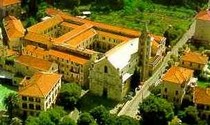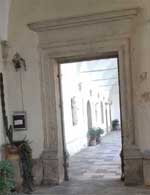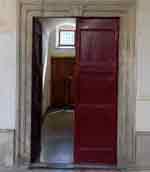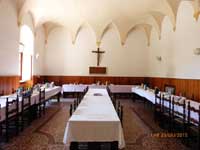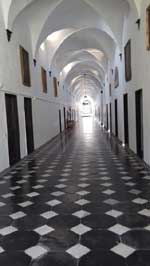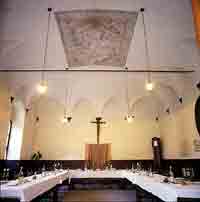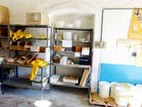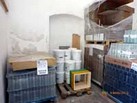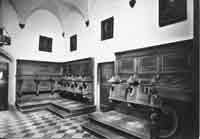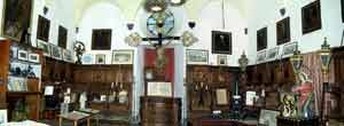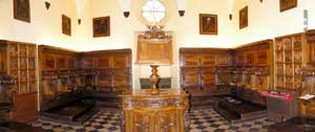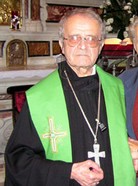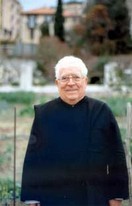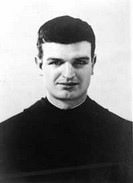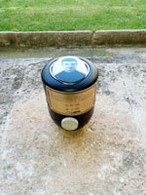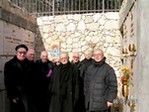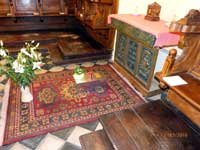portal 2
Documents
THE PATH
The first thing we notice from the north side of our portal is the date carved in the intrados, that is, on the internal ceiling of the portal: 1522.
This date corresponds to the period of the first priory of this monastery (1518-1523) by Fra 'Angelo di Albenga, who was therefore responsible for the construction of this monumental portal.
But it is in the manuscript of his autobiography, composed by Fra 'Angelo himself - in his Renaissance Latin (actually, a little macaronic) that was slowly turning into Italian - that we get further and interesting information.
"Ad perpetuam rei memoriam, in Anno M. D. XXXIII. adi five of Junio we have done to Consecrate ... the doe doors of the Claustro videlicet from the door of the monastery in the end to the Sacristy and up to the door of the second cloister where he sculpted in . lo freixo La Madona. Santo Hieronymo et Santo [Benedict] ...
The Episcopo was the Most Reverend Domino Domino Dominico de la Crovara de Grimaldis. de Genua Episcopo Sabbatense. and our Conservative ".
When the consecration of these two doors took place, Fra Angelo di Albenga was already in the third priory of this monastery (1532-34) and was about to become its first Abbot (1534).
Below we also see the door with the corridor that allows the passage to various rooms: dormitory, refectory, vegetable garden ...
The monks could descend, via an internal staircase, from the dormitory to the refectory floor.
From here, after lunch and then also after dinner, they could pass through the door, under the crucifix, into the adjacent room and (always chanting the Miserere) continue their journey towards the Church.
The photo of the refectory with the door under the crucifix, covered by a curtain, was taken by Don Andrea Pelliccia (1923-2000) with a 6x6 reflex camera, in the first half of the last century.
A monk of over 80 years, who entered this monastery in 1958, declares that he has never crossed this door to make the route in question.
Today we enter the room adjacent to the refectory, passing through the monastery garden: the door that connected the two rooms (Refectory and adjacent room) has been bricked up for some time.
In the row of photos below, 1 with the inscription Grills, shows us a series of openings of the monastery towards the garden: The brown door of the corridor (to go to the second cloister), The two windows of the refectory with grates, The gray door with protruding canopy in green material, which opens into the room adjacent to the refectory (that of the cistern).
In photo 2 with the inscription room adjacent to the refectory you can see in the wall the compartment (with a metal shelf inserted) where once there was the door to the refectory. Right in front of the entrance door, which leads to this place from the garden, there is photo 3 with the inscription Door towards the first cloister.
To the left of this door, now hidden by piles of boxes, there is still a small round well, which allowed the precious rainwater to be brought up, which flowed from the roof into the cistern located under the floor of this room.In photo 4, with the words Breakfast, you can see what the previous door looks like now, seen from the portico of the first cloister. This door was used a lot by the monks to make their morning breakfast in this room. But when the cellarer Don Placido Colabattista (future Abbot) arranged for this purpose (1954) the room in front of the refectory entrance (because it was much closer to the kitchen), the room above the cistern fell into disuse and was transformed into a warehouse. .
In photo 5 we can see the door of photo 4 right at the bottom of the left colonnade, with all the other doors (with a window) on the east side of the cloister.
In photo 6 we see the room where there was the door to communicate with the Chapter, from the room adjacent to the refectory.
4) The stalls of the following Chapter Hall have a history.
Shortly before 1900 it was decided to eliminate them because they were too old.
So they disassembled and were piled up in the first cloister, but not under the arcades (they would have been too bulky), but left outside, to the elements.
But some experts noticed the nonsense that the mania for the new had caused.
In other words, a work of art by Antonio da Venezia, a famous inlayer from the first half of the 1500, had been eliminated, to whom we owed many works preciously preserved in our church (such as the splendid inlays in the sacristy). Thus the stalls were recovered, restored and our Chapter Hall was furnished with them.
But here the new air that began to blow with the Second Vatican Council was so misinterpreted that dust began to accumulate on these stalls, no longer used for monastic prayer.
Fr Andrea Pelliccia, who came from his native Subiaco to Finalpia for health reasons, thought it appropriate to use this room to make an exhibition on the liturgical life of Benedictine monks.
This exhibition disappeared when the splendid and ancient portal of the Chapter Hall was discovered in 2000, because the Abbot Roman Cecolin had the Hall cleaned and restored several times to re-assign it to the recitation of the liturgical prayer of the monks (usually Sixth and occasionally Compline ).
One of the reasons why it is neglected today is because the place cannot be heated.
The wood of the stalls, even after 5 centuries, continues to be sensitive to changes in temperature and requires continuous (and expensive) assistance from specialized personnel: only woodworms can continue their work undeterred.
Even the age of some monks is more sensitive to an unheated environment, particularly when the weather becomes cold and humid: but there is still no specialized staff to eliminate the deleterious effects on human health, which the passage of time brings with it. , especially in the winter season.
SORE POINT , FUNERAL USE OF THE CHAPTER
When a monk dies, his coffin is usually displayed in the Chapter.
Here the monks and parishioners come for a personal prayer and a greeting.
Here we gather as a community (monks with parishioners) to recite the Holy Rosary, after 8.30 pm, until the day of the burial.
Sometimes the coffin is exhibited in the adjacent Hall, which is much larger.
5- Coffin of the Abbot Emeritus Fr. Placido (1919-2016).
8- Fr. Mauro Ballatori (+27/03/2018) requested the exhumation of Friar Bonifacio Pelassa, (1930-1961) - who died suddenly of heart problems.
With great surprise, the body of Fra Bonifacio turned out to be intact (after 56 years) and had to be cremated.
9. 1-Friar Bonifacio Pelassa
9.2 Urn with the ashes of Fra Bonifacio photographed on the wall of the cloister, in front of the entrance to the Chapter.
10-Two Abbots and Five monks in the Cemetery on 06-02-2006, with Scolastica Pelliccia, who had her brother Fr. Andrea Pelliccia, who had already rested there since 2000.
Actually, until recently we were still 2 on the waiting list to go into the number of the most. But here, precisely on the evening of June 23rd 2022, Also Don Giuseppe Fiorito (who in this photo we see hidden, against the back wall, between Don Carlo and Don Michele) moved and quietly, quietly entered the world of most. Sit tibi pax frater dilecte!(Peace be to you, beloved brother)
Ildebrando Minzolini
We have seen that Fr. Mauro took the place of Fra Bonifacio, who had to be cremated because he was still intact (60 years after his burial): we also saw the particular urn, which collected his ashes.
But whose place did Abbot Placido take?
of Ildebrando Minzolini, whose life is worth narrating even if only briefly.
He was born in 1890 and managed to live in a particularly warlike period ...
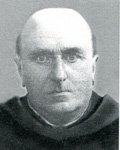 He entered Finalpia at a very young age, just opened (1905), and issued the ma. Religious profession on March 12, 1907. he completed his high school and theological studies in the monastery. He then had to suspend his studies for military service, first for the Libyan war of 1911 (at the age of 21) and then to participate in the First World War of 1915-18. Having returned permanently to the monastery, he completed his studies and was ordained a priest on 8 December 1920.
He entered Finalpia at a very young age, just opened (1905), and issued the ma. Religious profession on March 12, 1907. he completed his high school and theological studies in the monastery. He then had to suspend his studies for military service, first for the Libyan war of 1911 (at the age of 21) and then to participate in the First World War of 1915-18. Having returned permanently to the monastery, he completed his studies and was ordained a priest on 8 December 1920.For his open intelligence and. for his profound culture and his common sense he was destined to teach in the monastery and outside. He taught Liturgy, Ecclesiastical History and Canon Law for many years in the Episcopal Seminary of Albenga, and was part of the Ecclesiastical Tribunal of Savona.
He joined the direction of the Liturgical Review collaborating with many articles and edited it until 1940, when he was again called to military service as chaplain, providding his work at the Lancia military hospital in Finalpia.
He was for many years Cellerario treasurer of the monastery, and his aspiration and concern was to complete the construction of the monastery. With commendable industriousness he himself worked in the midst of difficulties and sufferings of all kinds, given the critical moments of the war (1940-45). Box with the remains of Fr. Minzolini in the Chapter
He completed the second cloister in 1943 and began the reconstruction after the bombing in September 1944. With tenacity and in the midst of a thousand bureaucratic and financial difficulties he could see this effort accomplished. But how many steps, how many prayers and many times how many humiliations and tears this work cost him.
Yet in the midst of so much industriousness, he found time to welcome those who came to him for advice, comfort and help. Only the Lord can measure the good that he silently sowed .. he always had an appropriate, serene, pacifying word for everyone.
<< Detail of the box of P. Minzolini remanins after 65 years from his burial.
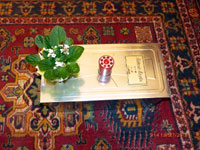 The Lord called him to himself after two months of a painful illness, endured with Christian resignation at the age of 67, in 1957
The Lord called him to himself after two months of a painful illness, endured with Christian resignation at the age of 67, in 1957His funeral showed how esteemed and loved he was.
He left a large void in the Community of Finalpia, filled only by faith and by the hope that he will continue his work from Heaven.
Today 5 July 2022 we return to the Chapter to discover one of the many uses
which over time have proved appropriate.
In 2005 our Church was in full turmoil
and precisely in the period of Holy Week, due to the ongoing restorations.
Tradition has it that after the liturgical function of Holy Thursday,
(which that year fell on March 24)
the Eucharist is kept in the so-called Sepulcher (sumptuously adorned),
to be visited by the faithful throughout the evening.
In church it was completely unthinkable to do so, in the sacristy as well.
The only suitable, close and easily adaptable place remained the Chapter.
